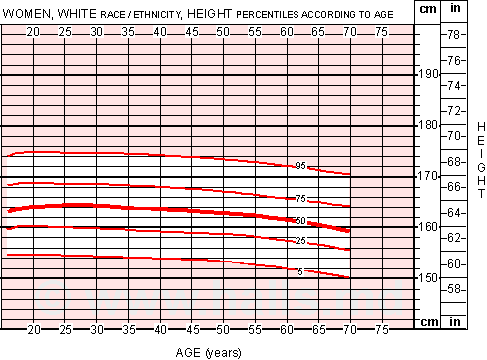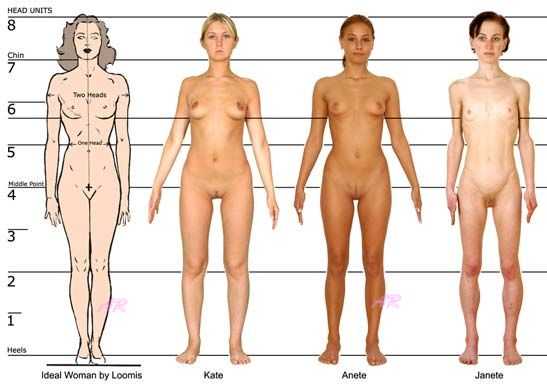
Average Body Size
and Feminizing Hormone Therapy
Additional chapters in This Section include:
Gender Reassignment Surgery
Orchiectomy for MTF Transsexual Women
FFS Facial Feminization Surgery
MTF Transsexual Surgeries
Hormone Replacement Therapy for Transgender Women
Female Hormone Therapy MTF Transsexuals
Breast Development in MTF Transsexuals
MTF Transsexual Breast Enlargement
Breast Augmentation MTF Transsexuals
Lactation and the Transsexual Woman
Injecting Silicone for Transsexual Women
Brazilian Hips and Buttock Enlargement
Average Body Size MTF Transgender
Male and Female Skeleton Transsexuals
Treatment of Young Transsexuals
Puberty in Adolescents MTF Transgender
Treatment of Young MTF Transsexuals
Treatment of Intersex Infants
Androgen Insensitivity Syndrome
Female Physical Beauty Transgender
Transgender Female Beauty
Exercise, Fitness and Diet for Transsexual Women


This page relates and compares the average sizes of American (USA) men and women, there also are some notes relating to transsexual women at the end.
|


Measurements of height and weight have little overlap between male and females, and thus can be used to correctly distinguish between men and women 9 out of 10 times.
|
Several sets of tables of anthropometrical measurements are provided here. The first set is derived from MIL-STD-1472D that relates and compares the typical sizes of American men and women for Human Engineering uses, more than 1000 students were measured to collect the data. The second set is derived from a 1997 study for the US Defense Logistics Agency, a group of 127 U.S. Army recruits (60 males and 67 females) were measured for some two dozen dimensions relevant to military dress clothing. For interest, standard garment sizes are listed in a table 3. The fourth set is from the book "Body Composition and Physical Appearance: Applications for the Military Services, (1992)" which compares the size and body composition of 30 to 39 year old males and females in Michigan. Finally, some interesting percentile graphs from
Halls
are provided, unfortunately the data source is not stated.
|
There are a few strange anomalies (possibly errors) in the results, but it's not possible to resolve these without access to the original data.
Only table set 1 is considered for the findings because of the larger sample and the far more comprehensive data. However it is interesting to compare the tables 1 and 2, generally the measurements in table set 2 are slightly less than those in set 1.
|

Notes to Tables:
All measurements are in inches
|
Clothing sizes are USA standards, not UK
|
A small number of the figures would appear strange and probably erroneous, but lacking access to the original source material it is impossible to correct these.
|
Adding and subtracting the standard deviation sigma will give a range that includes about 68.3% of the male or female population
|
Adding or subtracting (2 x sigma) will include about 95.4% of the population
|
Adding or subtracting (3 x sigma) will include about 99.7% of the population
|
E.g. About 68.3 % of women are between 61.67 and 66.83 inches in height, and 99.7% are between 56.51 and 71.99 inches in height.
|
Table Set 1
|
IN HEIGHT FROM THE GROUND
|
|
ITEM
|
|
Male
|
|
sigma
|
Female
|
sigma
|
Male
|
Female
|
(inch)
|
+/-
|
(inch)
|
+/-
|
Normalised to height
|
Top of Head
|
|
68.60
|
|
2.74
|
64.25
|
2.58
|
1.000
|
1.000
|
Shoulder
|
|
56.65
|
|
2.46
|
52.50
|
2.49
|
.826
|
.817
|
Nipple
|
|
50.05
|
|
2.22
|
46.65
|
2.22
|
.730
|
.726
|
Elbow
|
|
43.10
|
|
2.01
|
40.50
|
1.88
|
.628
|
.630
|
Waist
|
|
41.65
|
|
2.22
|
40.00
|
2.07
|
.607
|
.623
|
Crotch
|
|
33.05
|
|
1.85
|
29.90
|
1.89
|
.482
|
.465
|
Knee (top)
|
|
20.90
|
|
1.34
|
18.95
|
1.06
|
.305
|
.295
|
DIFFERENCE MEASUREMENTS:
|
ITEM
|
|
Male
|
|
sigma
|
Female
|
sigma
|
Male
|
Female
|
(inch)
|
+/-
|
(inch)
|
+/-
|
Normalised to height
|
Shoulder-Crotch/Torso Length
|
|
23.60
|
|
2.16
|
22.60
|
2.19
|
.344
|
.352
|
Shoulder-Knee
|
|
35.75
|
|
1.90
|
33.55
|
1.78
|
.521
|
.522
|
HEAD / HAND / FOOT SIZES
|
ITEM
|
|
Male
|
|
sigma
|
Female
|
sigma
|
Male
|
Female
|
(inch)
|
+/-
|
(inch)
|
+/-
|
Normalised to height
|
Head Circumference
|
|
22.05
|
|
.68
|
21.65
|
.66
|
.321
|
.337
|
Head Breadth
|
|
6.00
|
|
.25
|
5.73
|
.24
|
.087
|
.089
|
Ear Length (Height)
|
|
2.45
|
|
.17
|
2.06
|
.17
|
.036
|
.032
|
Neck Circ./Size
|
|
14.80
|
|
.79
|
13.10
|
.79
|
.216
|
.204
|
Palm Length
|
|
4.19
|
|
.26
|
3.90
|
.21
|
.061
|
.061
|
Hand Length
|
|
7.49
|
|
.39
|
7.10
|
.48
|
.109
|
.111
|
Finger Length
|
|
3.30
|
|
.32
|
3.20
|
.35
|
.048
|
.050
|
Hand Breadth
|
|
3.52
|
|
.19
|
3.03
|
.19
|
.051
|
.047
|
Hand Circumference
|
|
8.48
|
|
.49
|
7.22
|
.36
|
.124
|
.112
|
Glove Size
|
|
XLarge
|
|
Medium
|
Heel/Ankle Circumference
|
|
13.45
|
|
.68
|
12.16
|
.58
|
.196
|
.189
|
Foot Circ. at ball
|
|
9.83
|
|
.59
|
8.91
|
.45
|
.143
|
.139
|
Foot Breadth
|
|
3.91
|
|
.23
|
3.50
|
.21
|
.057
|
.054
|
Foot Length
|
|
10.53
|
|
.53
|
9.58
|
.51
|
.153
|
.149
|
Shoe Size
|
|
Size 10.5
|
|
Size 8
|
MISCELLANEOUS
|
ITEM
|
|
Male
|
|
sigma
|
Female
|
sigma
|
Male
|
Female
|
(inch)
|
+/-
|
(inch)
|
+/-
|
Normalised to height
|
Bust Size
|
|
37.35
|
|
2.64
|
35.15
|
2.64
|
.544
|
.547
|
|
|
Size 10
|
Waist Size
|
|
32.35
|
|
3.31
|
28.15
|
|
2.89
|
|
.472
|
.438
|
|
Size 16W
|
|
Size 14/12W
|
|
|
Hip Size
|
|
37.80
|
|
2.61
|
37.75
|
2.46
|
.551
|
.588
|
|
Size 12W
|
|
Size 12
|
Trunk Circumference
|
|
64.80
|
3.34
|
|
60.75
|
|
2.89
|
|
.945
|
.946
|
|
Size 17
|
|
Size 11
|
|
Table Set 2
ITEM
|
Male (n=60)
|
Female (n=67)
|
Mean
|
|
sigma
|
|
Mean
|
sigma
|
(inch)
|
|
+/-
|
(inch)
|
+/-
|
Bicep Circumference, Flexed
|
|
11.16
|
|
0.91
|
Buttock Circumference
|
|
37.85
|
|
2.98
|
38.34
|
2.26
|
Chest Circumference
|
|
38.11
|
|
2.98
|
36.21
|
2.59
|
Chest Circumference, Scye
|
|
35.77
|
|
2.16
|
Coat Length¬
|
|
27.36
|
|
1.41
|
25.77
|
1.09
|
Crotch Height
|
|
32.68
|
|
2.18
|
30.81
|
1.75
|
Inside Sleeve Length, Right¬
|
|
18.73
|
|
1.28
|
17.50
|
1.19
|
Interscye II
|
|
14.93
|
|
0.91
|
Rise, NI¬
|
|
11.15
|
|
0.84
|
10.20
|
0.77
|
Shoulder Circumference
|
|
45.81
|
|
3.00
|
|
Shoulder Slope, Right¬
|
2.20
|
|
0.50
|
1.73
|
0.28
|
Bust Position¬
|
|
13.27
|
|
0.99
|
Waist Circumference, NI
|
|
31.86
|
|
3.08
|
28.97
|
2.42
|
Waist Circumference, O
|
|
32.76
|
|
3.50
|
|
Waist Height, O
|
41.32
|
|
2.39
|
Waist Height, NI
|
|
41.01
|
|
2.07
|
Front Waist Length, O¬
|
|
21.23
|
|
1.21
|
Skirt Length, NI¬
|
|
23.24
|
|
1.23
|
Stature
|
|
68.37
|
|
3.07
|
63.76
|
2.25
|
Weight (pounds)
|
|
160.43
|
|
29.90
|
138.20
|
19.12
|
Key:
|
NI = natural indentation
O = Omphalion
¬ = Calculated dimensions
|
Table Set 3
|

For reference, standard measurements for garment sizes are:
|
SIZE
|
FEMALE
|
|
MALE
|
Hips
|
|
Waist
|
Waist
|
X-Small
|
32"-34"
|
22"-24"
|
Small
|
35"-36"
|
25"-26"
|
28"-30"
|
Medium
|
37"-39"
|
27"-29"
|
32"-34"
|
Large
|
40"-41"
|
30"-31"
|
36"-38"
|
X-Large
|
42"-43"
|
32"-33"
|
40"-42"
|
Table Set 4
|
Correspondence between Male and Female Percentiles for Size and Body Composition:
MEASURE
|
Male Centiles Corresponding to:
|
|
Women's 50th Percentile
|
|
Women's 85th Percentile
|
Height
|
2.0
|
|
13.1
|
Weight
|
|
7.0
|
|
40.6
|
Fat Weight
|
|
34.0
|
|
88.5
|
Lean body Weight
|
|
2.3
|
|
18.1
|
Bone Area
|
|
3.4
|
|
10.4
|
Cortical Area
|
|
2.0
|
|
14.0
|
Medullary Area
|
|
34.4
|
|
48.0
|
Skeletal Weight
|
|
0.8
|
|
8.4
|
An example of how to read the table: the fiftieth percentile for height in women corresponds to the second percentile in men, i.e. half of all women are shorter than the shortest 2% of all men. Also 85% of women are shorter than the shortest 13.1% of men.
|
|
Graph's
|
The following two tables show weight and height percentiles for American Caucasian women:
|


As an example of how to read the tables, a 40 year old woman who is about 174cm tall (5ft 8 inches) is on the 95 percentile, i.e. only 5% of all women are shorter. The tables for men are not shown, but a 40 year old man at the 50 percentile (i.e. average) is about 179 cm (5ft 10 inches) tall.
|
Some Findings:
The numbers confirm some things we know instinctively, but disprove others:
|
Men are taller than women, by 4.34 inches on average
|
Women have proportionally longer torso's (35.2% of height vs. 34.4%)
|
Men are leggier, if looked at from the crotch (48.3% vs. 46.5%) ....
|
.... although women are leggier if looked at from the waist (62.3% vs. 60.7%)
|
Men have longer thigh's (17.7% vs. 17.0%) and longer calves (30.5% vs. 29.5%)
|
Women have bigger heads then men, relative to height
|
Stature, bone area, cortical area and skeletal weight all offer an excellent means of differentiating between men and women
|
The average man is taller than more than 97% of women from the same ethnic group - a surprisingly high number until high heels are discounted. The widespread assumption that women have relatively longer legs than men also seems to be based more on high heels and short skirts than fact.

Only Table Set 1 is considered further
Effects of Female Hormones - Started Before Puberty

Based primarily on studies of AIS women and a small number of male babies re-assigned female at birth, it does seems that the
early hormone treatment
of a transsexual boy-to-girl has a significant effect on the physique. The limited evidence suggests that typically a transsexual woman who started hormones before the on-set of male puberty will as an adult be statistically of normal female size and proportions for a woman of her height and weight, excepting some primarily skeletal related items such as hands and feet.

Pre-SRS Michelle shows off her body.
|
It's thought that the male "Y" chromosome is mainly responsible for growth so as the girl is genetically "XY" there will inevitably be some degree of skeletal masculinization. However early female hormone treatment (perhaps combined with surgical
removal of the testes
) will reduce levels of "male" androgen hormones such as testosterone, and this seems to have some slight benefits, for example slightly broadening the pelvis and reducing the girls adult height (by perhaps an inch) compared with if she had experienced a male puberty.

In general, physical characteristics primarily determined by the body skeleton (e.g. height, size and shape of hands and feet) will lie between the male and female norms post-puberty - although tending more towards the former than the later. This not necessarily bad as the western idea of feminine beauty is for tall and leggy women. As an adult, compared to the average woman, the girl will typically be tall (67.5" vs. 64.25") and have long legs - both absolutely (32.4" vs. 29.9") and relative (48.3% vs. 46.5%) to her height.
Body shape is primarily controlled by estrogen so its
early use
allows a normal female body shape to develop, particularly if taken while the body is at its most receptive age - the critical puberty years between about 11 and 15 (depending on the individual). In this case the girl's final post-puberty body shape and "figure" will be obviously female, far closer to genetic female than genetic male in its characteristics. During this key period it is also quite possible (although still rarely done with transsexual boy-to-girls) for an endocrinologist to adjust (slightly increase) the estrogen dosage of a girl who seems likely to be undesirably tall so as to slow and prematurely stop her bone growth, thereby reducing her final adult height to within female norms.
 A graphic comparing the ideal female (as drawn by Andrew Loomis) against
two real genetically XX women and an intersex woman, all in their 20's
A graphic comparing the ideal female (as drawn by Andrew Loomis) against
two real genetically XX women and an intersex woman, all in their 20's

A painter with a transsexual model who has extraordinary mix of strongly male and strongly female physical characteristics.
|
Effects of Female Hormones - Started After Puberty
Male-to-female transsexuals undergoing sex reassignment after puberty have the major disadvantage in that a normal and average degree of hormonal masculinization has already taken place. Medical
studies
indicate that a male-to-female transsexual who starts hormone and gender reassignment treatment as an adult will have a male physique normal for his age. There is absolutely no evidence that his/her body is likely to be more "feminine" in its size, proportions and characteristics than any other man.
|
Whilst female hormones have many feminization benefits, the complete reversal and elimination of all the male characteristics already induced by male sex hormones is not possible. In particular, the previous effects of androgens on the skeleton (the average greater height, the size and shape of hand, feet, jaws, and of the male type pelvis) cannot be reversed by female hormone treatment. Only major and dangerous surgery can feminize the appearance of [some] of these masculinized bones, otherwise the physical characteristics of the transsexual determined primarily by the body skeleton will remain constant and probably typically "male" in their absolute size.
|

|

|
A selection of transsexual and intersex (third from left) woman who began hormones after puberty and have tried a career as a model. They all have one disadvantage - no "hour glass" figure and a waistline noticeably greater than their XY counterparts. Even transgendered supermodel Andreja Pejic (right) has this problem, despite rigorous dieting that has kept her 72 inches (183 cm) tall frame down to just 158 lbs (72 kg)
|

However, skeletal size does show a considerable overlap between the sexes, so in some transsexual women the residual male physical characteristics will be far less visible than in others. For example, about 25% of MTF transsexuals are lucky enough to be of normal female height (between about 61½" and 67" in the USA), although conversely about 35% will be exceptionally tall (over 69½") for a woman. One
study
of 74 post-SRS women found that their average height was 70 inches with a sigma of ± 2 inches; this is rather tall even compared with men. Indeed, while genetic women over 6 feet tall are rare (just 2% of the population), nearly 15% of transsexual women reach this height - handy if they have the age and looks to be a model (aka
Tula
) but probably rather too noticeable otherwise.
|

Even in the late starter, a combination of long-term hormone use and a willingness to resort to surgery can result an extremely feminine overall body shape - but note that the waist is still not "Barbie" .
|
Hormones will of course affect and feminize many secondary sexual characteristics such as fat distribution, musculature and breast development, thereby altering some physical characteristics (e.g. breast size and waist) more towards female norms in proportions, although they're very unlikely to ever actually reach these. Typically, the MTF transsexual will lose about 9 lbs (4 kg) of lean body mass (muscle), but will more than replace this with female type fat and other tissue (e.g. breast) deposits, indeed an overall weight gain of up to 11 lbs (5 kg) is quite normal if there is no change in life style.
|

Copyright (c) 2003, Annie Richards
Last updated: 15 August 2004

















 A graphic comparing the ideal female (as drawn by Andrew Loomis) against
two real genetically XX women and an intersex woman, all in their 20's
A graphic comparing the ideal female (as drawn by Andrew Loomis) against
two real genetically XX women and an intersex woman, all in their 20's


